Introduction
Silicone hydrogel lenses were launched around the world in 1999, and they have started to become mainstream products in a number of markets. However, it can be difficult to obtain information about the popularity of these and other contact lens types because these types of data can be commercially sensitive and there is usually considerable expense in undertaking consumer surveys for products such as contact lenses which are used by five to ten per cent of the population in a typical market.
For a number of years we have taken a different approach to understanding the contact lens market – by surveying practitioners rather than wearers/consumers. Additionally, we have adopted a prospective rather than a retrospective methodology. That is, rather than asking practitioners to estimate the lens types they have prescribed over a historical period, we request actual lens and care system information for a specified number of future fits.
Asking practitioners rather than wearers/consumers elicits information which is likely to be ‘cutting edge’ in terms of contact lens practice. For example, when daily disposable lenses were introduced, their immediate popularity at the clinician-level for some countries was illustrated by this practitioner-centric approach. Any new lens type takes some time to impact on the usage data within the whole contact lens wearer base (with many wearers using lens types which were prescribed years previously). Therefore asking consumers about their lens types is less appropriate when gauging the success or otherwise of new product types.
Methodology
This report focuses on the use of silicone hydrogel lenses in 2003 in ten countries (Table 1). In the larger countries, 1000 surveys were randomly sent to contact lens practitioners selected from national registers of qualified clinicians. In Norway and Singapore, where the number of practitioners is lower than 1,000, a pro rata quantity of surveys was mailed out. The survey forms elicited prospective information about the type of contact lenses and care products prescribed to a maximum of 10 patients fitted after the commencement of the study. A system of weighting was employed to better reflect the fitting practices of busier practitioners.
Table 1: Countries analysed in this survey (national survey coordinators)
|
Australia (Craig A Woods PhD MCOptom DipCLP FAAO)
Belgium (Eef van der Worp BSc FAAO FIACLE)
Canada (Deborah Jones BSc FCOptom DipCLP FAAO)
Greece (Ioannis G Tranoudis DO MSc PhD)
Japan (Motozumi Itoi MD PhD)
Netherlands (Eef van der Worp BSc FAAO FIACLE)
Norway (Magne Helland BSc MScOptom FIACLE)
Singapore (Anna Yeo Chwee Hong BOptom (Hons) M App Sc FIACLE)
United Kingdom (Nathan Efron DSc MCOptom FAAO (DipCL))
United States (Joseph T Barr, OD MS) |
Demographics and general information
We received data about 13,787 contact lens fits conducted in 2003 with the greatest number in Japan (4,609). The general results from these fits has been reported elsewhere (1). Women accounted for two thirds of all fits, and the mean age of patients was lowest in Singapore (26.5 years) and highest in the United States (34.1 years).
Extended wear fits
Figure 1 shows the proportion of soft lens fits for which an extended wear modality was prescribed. This ranged from about 1% of fits in Japan to 20% in the United States, with high levels of extended wear prescribing also in Australia (17%) and Norway (14%). Generally, silicone hydrogels were the lenses of choice for extended wear (Figure 2), with this lens type accounting for over 90 percent of extended wear fits in Australia, Norway and the United Kingdom. The popularity of extended wear (and the use of silicone hydrogels for extended wear in particular) in Australia is explained by Noel Brennan, of Brennan Consultants, Melbourne. He notes that Australian practitioners are well educated and historically have heeded the advice of educators in the field. This resulted in a low uptake of extended wear with conventional hydrogels through the 1990s, and a generally positive response to silicone hydrogels since their launch.
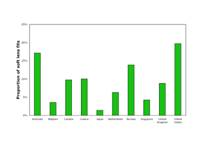
|

|
Figure 1: Extended wear as a proportion of all soft lens fits - click to enlarge |
Figure 2: Proportion of extended wear fits that are silicone hydrogels - click to enlarge |
The lowest use of silicone hydrogels for extended wear was in Greece (41 percent) and the United States (52 percent) with the exception of Japan where this lens type is not available. This indicates, for example, that about half of all lenses prescribed for extended wear in the United States are manufactured from ‘conventional’ (i.e. non silicone hydrogel) materials. This is probably explained by the historical use of conventional hydrogels for extended wear; this type of contact lens prescribing dwindled in most countries during the 1990s, but remained relatively popular in the United States. This, coupled with the fact that silicone hydrogels were introduced later into the United States than in Europe, Australia and Canada, suggests that it may take some time for silicone hydrogels to reach a stage where they account for more than 90% of extended wear fits in the United States.
In some countries, extended wear remains an unusual modality. The Netherlands has the highest wearer base for contact lenses as a proportion of the population in Europe, and only six per cent of soft lens fits are for extended wear. Some insight into this is provided by Eef van der Worp of the Hogeschool van Utrecht. He explains that there are various forms of contact lens practitioners in the Netherlands and that historically, most of their expertise is in the area of lens fitting rather than ongoing management (this probably also accounts for the popularity of ortho-keratology in the Netherlands). In addition to the generally conservative nature of Dutch contact lens practice, this explains the low uptake of silicone hydrogel extended wear in this very successful contact lens country.
Daily wear fits

|
Figure 3: Proportion
of daily wear fits that are silicone hydrogels - click
to enlarge |
Until the launch of Acuvue Advance (Johnson & Johnson) at the end of 2003, the other commercially-available silicone hydrogel products (PureVision from Bausch & Lomb and Focus Night & Day from CIBA Vision) were principally marketed for extended wear use. Many practitioners have also opted to use the lenses on a daily wear basis (Figure 3). In Australia, for example, about 11% of soft lens daily wear fits are with silicone hydrogel lenses and this figure is over 4% in Belgium, Canada and the United States.
Who is being fitted?
It is apparent that the demographic make-up of silicone hydrogel wearers is different than for contact lens wearers generally. For example, Figure 4 shows that a greater proportion of refit patients are being prescribed extended wear lenses than new fits. Across all countries studied, people with previous contact lens experience are more than twice as likely to be prescribed extended wear lenses than those with no previous experience. The logic for this is quite sound. With extended wear associated with a higher number of adverse events than daily wear, practitioners are keen to have knowledge of previous contact lens success with a patient before moving them to extended wear, rather than moving directly from no contact lens wear into this modality. With increasing practitioner experience, the tendency to adopt this strategy might decline, but at the present time, this is a clear effect. Extended wear patients are more likely to be male (Figure 5) and are about three years older at fitting (Figure 6) compared to daily wear patients.

|

|

|
| Figure 4: Extended wear for new fits
and refits in Australia (AU), United Kingdom (UK) and United
States (US) - click to enlarge |
Figure 5: Daily wear and extended
wear fits to male patients - click to enlarge |
Figure 6: Extended wear patients are
typically three years older than daily wear patients - click
to enlarge |
Who is doing the fitting?
In Australia, 65% of responding practitioners reported some degree of extended wear fitting compared with 37% in the United Kingdom and 57% in the United States (Figure 7). This seems to suggest that patients being fitted with silicone hydrogel lenses are supplied by a large number of practitioners for whom this lens type forms part of their practice, rather than a small number of ‘specialist’ fitters using this lens type for a very high proportion of lens fits. This observation is supported by the observation that the number of extended wear fits conducted by a practitioner is not related to either the number of years they have been fitting contact lenses (Figure 8) or their contact lens activity (Figure 9)
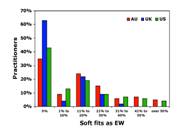
|
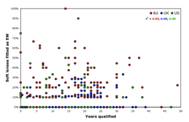
|
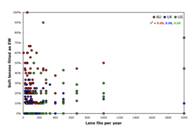
|
| Figure 7: The proportion of extended
wear fits performed by contact lens practitioners - click
to enlarge |
Figure 8: There appears to be little
relationship between practitioner experience and the proportion
of extended wear lenses prescribed - click to enlarge |
Figure 9: Busier practitioners do
not appear to fit more or less extended wear than less active
contact lens practitioners - click to enlarge |
The future for silicone hydrogels
More recent developments in the field suggest that silicone hydrogel materials will be used increasingly for daily wear. It is clear that as an extended wear product, silicone hydrogels have seen an increase in popularity since their launch in 1999 (Figure 10). Extended wear fits now account for 10 to 20 per cent of lens fits in some major markets and silicone hydrogels represent a majority of these.
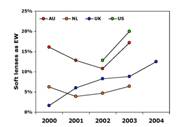
|
Figure 10:
Soft lens extended wear fits from 2000 - click
to enlarge |
Reference
- Morgan PB, Efron N, Woods CA, Jones D, Tranoudis I, Itoi M, van der Worp E, Helland M, Hong AYC, Barr JT. International contact lens prescribing in 2003. Contact Lens Spectrum 2004; 19(1): 34-37.
|